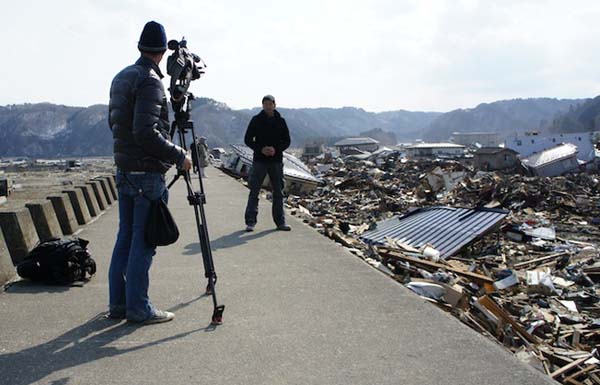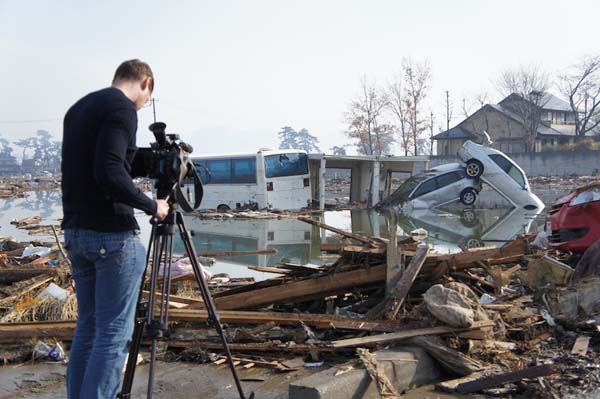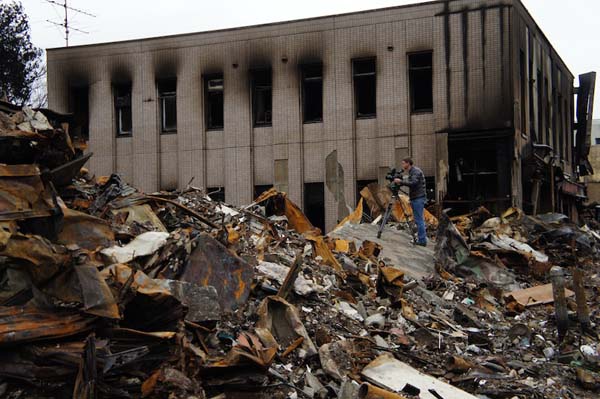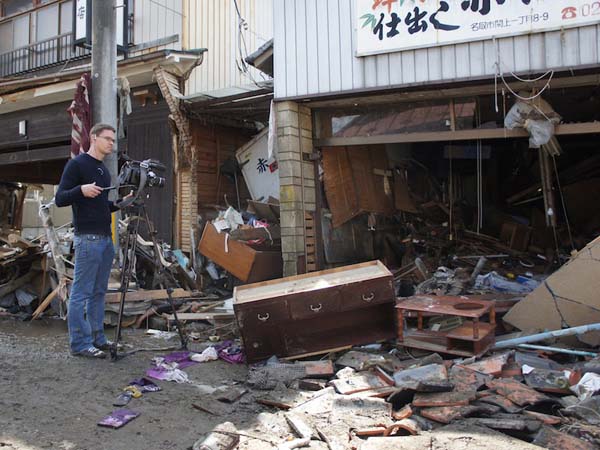On March 11th at 14:46 local time, a huge magnitude 9.0 earthquake struck Japan. It was the biggest to strike Japan in its history and the fifth largest quake recorded worldwide since 1900. The death toll is now nearly 15,000 and 12,000 people are still missing. Japan is built to withstand earthquakes, but what ultimately caused the devastation and took so many lives was the massive tsunami that followed.
I was alerted about the initial earthquake by a close friend in Tokyo and quickly turned on the TV. Initially, the earthquake did not seem to have caused too much damage, but as I continued to watch, live pictures began to show a giant tsunami hitting and engulfing the northeast coast. The vision was incredible and I was at a loss for words. It reminded me of watching the World Trade Centre coming down, disbelieving. It was one of those terrible moments in history that everybody remembers.
I was deployed to Japan that evening to cover the disaster along with another cameraman, two correspondents and a producer, joined later by two other crews from Doha and Bangkok. Just getting to Japan was an effort. A lot of flights had been cancelled and getting hold of one last minute proved even more difficult. We eventually managed to get the last five seats on a Japan Airlines flight to Tokyo and flew through the night to arrive early next morning. As soon as we landed, we found out how badly transport and communication had been affected by the quake. We were forced to wait in the airport until our local producers and drivers managed to make their way to meet us. There was a massive traffic jam as the highways had been shut down, public transport had come to a halt, and there were shortages of available taxis and other vehicles. Local mobile phone networks had jammed up and that put us out of reach. Our driver had to fly in from Osaka to avoid the traffic, and just getting from Tokyo to Narita airport took the producers eight hours!
While waiting for them, we made use of our time doing live-crosses from the airport using rented local phones and 3G internet dongles. For the next several hours, these dongles enabled us to keep updating the world on the developing situations up north. Although we wanted to get to the affected areas as quickly as possible, we also knew it was necessary to be well prepared and have the correct people and vehicles in place. We knew that the story would go on for a long time – patience was key.

When the teams finally came together, we loaded up with food and water so we would be self sufficient and then split into two teams to head up north. We drove for hours through the cold night. It was pitch dark as there was no electricity in the affected areas and we were shaken awake whenever the van drove over the gaps and cracks gaping on the roads.
On this assignment, I took four cameras with me to give me the greatest flexibility in covering the story: my normal XDCAM PMW-350, my new Sony PMW-F3, my Canon 7D and a small Canon handycam. On the first day, I left the PMW-350 with our deputy news editor Jeremy Custance, who used to be a cameraman. He was able to shoot live crosses using a Bgan while the local producer Aya Asakura and I went to collect elements for a story. I took the Sony PMW-F3 with a cheap Tamron 18-270mm lens attached via an MTF adaptor. This enabled me to have the greatest flexibility for focal lengths without having to change lenses. In situations like this it does not matter what camera you are using – what matters is how you use it. I used the F3 and the 350 throughout the coverage. The F3 became very useful in extreme low light situations and for doing live crosses. As it uses barely any power it was crucial in situations where re-charging batteries was difficult and no mains power was available. Using its i-link (firewire) connector I could use the camera through Quicklink to do live crosses. This camera produces beautiful images and quality is amazing even with a cheap Tamron zoom lens.

The first disaster-struck zone we reached was Natori, a city just south of Sendai. It was the second morning after the quake and local fire fighters and Japan’s Self Defense Force were to enter the area to start rescue operation for the first time. Everything looked fairly intact and normal to us until we drove a kilometre off the main road towards the ocean. As far as the eyes could see, there was devastation. We were still three or four kilometres from the sea and already, there were boats washed up on roads and destroyed houses and cars submerged everywhere. The closer you got to the coast, the worse it got – the tsunami had flattened the city, leaving no trace of what once used to be.
We made our way through the muddy ground, that still smelled raw and fresh from the damage. We saw fish from the ocean still gasping in a puddle. But soon, our shoot would be interrupted by repeated aftershocks and tsunami warnings that forced the rescue workers and us to run to higher ground. This became a common exercise throughout the coverage as the ground was still unstable.
Walking around through thick rubble, we found people still shell-shocked, sitting amongst their destroyed houses. Their stories were heartbreaking and the looks on their faces were those of complete shock. When we spoke to them, it was the look in their eyes and trembling hands that told us of the horrific disaster they experienced. I have covered and seen a lot of bad things over the past twenty years of doing news, but this was by far the worst destruction I had ever seen. I have never been a cameraman who likes getting up close to people who are obviously experiencing some of the worst moments of their life. You can still portray the situation without shoving a camera right in somebody’s face.
One moment still remains sharply in my mind. I saw from a distance two men who were waist deep in the water trying to get inside an upturned car. I filmed them from about 60 metres away. I did not want to get too close to them as I knew what they were looking for required privacy. While I was filming, they came face to face with their worst fears. Inside the car they found the bodies of their mother, a niece and a nephew. It was a heart-wrenching moment.
Over the next month I would continue to see things that made me shake my head in disbelief. Every day when you thought you could not possibly see anything worse, you would. I sometimes find disaster reports are put together in a fast paced way with no time for the viewer to take in and absorb the situation. I usually work with senior Asian correspondent Steve Chao, who has a unique ability to tell a story rather than just report on it. We always work very closely together so the best pictures and best words are combined.
As if to compound their already difficult situation, the fragile cities and villages received another aftershock of magnitude 7.1 on April 7th. I had got used to experiencing constant aftershocks but this one shook the building we were in very violently. You always see pictures on TV when a quake happens. Security cams show things falling off shelves and buildings moving but it is impossible to show how it feels to be in one. It felt like being in a snow globe that somebody was shaking. The walls and floor were physically moving and if you tried to stand up you just got thrown back down. Many told us that this quake cut the lifelines once again and almost broke their spirits when they were trying to muster courage to rebuild and move forward.
In terms of our coverage, we had to keep our own lifeline and one major challenge was keeping the car fuelled when many petrol stations were either destroyed or running low. Our super producer Aya Asakura managed to secure our van’s emergency vehicles pass, which enabled us to use restricted freeways and to get fuel from selected outlets. Without these two things we would have been grounded and unable to move around to cover the story. Basic things like this can make or break your coverage. What people do not realize when they are sitting at home watching stories from other countries is how much work is done by your local producer (commonly called a fixer in the TV world). It is not the correspondent who is finding the people you are talking to or getting you to the locations you need to go. The local producer is responsible for arranging your transport, translating, finding accommodation, finding people to talk to, setting up all the elements you need to shoot, finding out the background information and just about everything else. Without a great fixer your job becomes very difficult. In disasters like this they perform amazing tasks and keep your coverage going.
During the coverage, we moved to multiple locations, doing live crosses and producing stories around the clock. At times we were forced to move away from the east coast due to the growing nuclear radiation fears created by the damaged Fukushima nuclear plant owned by TEPCO. While the government was ordering people within 20-30km to evacuate, international experts were saying that the evacuation zone should cover wider areas. We were getting our directives from head office and were ordered to move at least 120km away. This meant long drives in and out each day to get to the affected areas and cover the developing story, but the safety of staff was the priority. It is so important to take extra safety steps, especially when it comes to radiation as you cannot smell, feel, or see it.
I spent 34 days covering the disaster and am currently back in Japan again continuing to report on the story. Despite the many long days without sleep and working in difficult conditions you never complain. You are constantly reminded of how lucky you are as the people you are meeting and seeing everyday have in most cases lost loved ones and everything they own. Although the scale of devastation still remains immense and has deeply scarred the cities and the people, there are daily changes. It continues to amaze me how solemnly determined and resilient the Japanese people are. They deal with loss and adversity with such poise and dignity. Most other countries would have been overwhelmed by a disaster of this magnitude, but just hours afterwards, the rescue crews and ordinary people were already hard at work. The image remains vividly in my mind.
About Matthew Allard, Aljazeera Senior Field Cameraman, Kuala Lumpur:
Matt has been a Camera/Editor in TV news for 20 years, previously working for both Channel 9 and Channel 10 in Australia. Twice Network Ten Australia’s cameraman of the year as well as being a Walkley Finalist for outstanding camerawork in 2006 (for coverage of the Cronulla Race Riots) and a Logie Finalist for outstanding news coverage 2006 (Bali 9). He has covered news events in more than 30 countries, from major sporting events to terrorist bombings. Based out of the Kuala Lumpur broadcast centre in Malaysia he is an avid user and follower of new technology, shooting stories on HD broadcast cameras as well as new Canon DSLRs.








